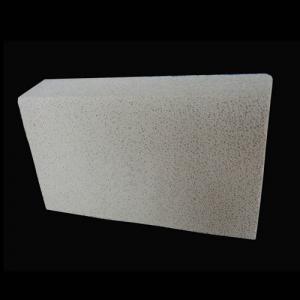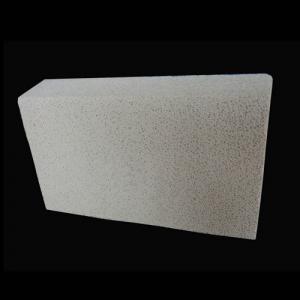Insulation Brick insulating brick insulating fire brick GJM23, GJM26, GJM28, GJM30, GJM32
- Loading Port:
- Shanghai
- Payment Terms:
- TT or LC
- Min Order Qty:
- 10 m.t.
- Supply Capability:
- 1000 m.t./month
OKorder Service Pledge
OKorder Financial Service
You Might Also Like
General Information of Insulating Fire Brick GJM23
Insulating fire bricks GJM23 are made from high purity alumina and low iron content raw materials. The insulating fire bricks are produced by mixing, casting or extruding, drying, sintering and grinding. Our insulating fire bricks GJM23 temperature is 1260℃(2300℉). A variety of type could be done according to customer’s request.
To make our firebricks more energy and cost effective, we have different manufacturing methods for our insulating fire bricks casting and extruding method.
For insulating fire bricks GJM23,we choose the casting methord.The casting insulating fire bricks offering the lowest density, the lowest thermal conductivity for the application above 1000℃.
General Information of Insulating Fire Brick GJM26
Insulating fire brick GJM26 are produced by mixing, casting or extruding, drying, sintering and grinding. Our insulating fire bricks GJM23 temperature is 1430℃(2600℉). We could supply a wide range of shapes.
To make our firebricks more energy and cost effective, we have different manufacturing methods for our insulating fire bricks casting and extruding method.
For insulating fire bricks GJM26,we choose the extruding method. Extruding insulating fire bricks have better strength and offering great performance in load bearing applications and in conditions where abrasion from mechanical abuse or flow of hot gases.
General Information of Insulating Fire Brick GJM28
Insulating fire brick GJM28 are produced by high purity alumina and low iron raw materials. A viariety of shapes are available.
To make our firebricks more energy and cost effective, we have different manufacturing methods for our insulating fire bricks casting and extruding method.
For insulating fire bricks GJM28,we choose the extruding method. Extruding insulating fire bricks have better strength and offering great performance in load bearing applications and in conditions where abrasion from mechanical abuse or flow of hot gases.
General Information of Insulating Fire Brick GJM30
Insulating fire brick GJM30 are produced by mixing, casting or extruding, drying, sintering and grinding. Our insulating fire bricks GJM30 temperature is 1430℃(2600℉). We could supply a wide range of shapes.
To make our firebricks more energy and cost effective, we have different manufacturing methods for our insulating fire bricks casting and extruding method.
For insulating fire bricks GJM30,we choose the extruding method. Extruding insulating fire bricks have better strength and offering great performance in load bearing applications and in conditions where abrasion from mechanical abuse or flow of hot gases.
Typical Application of Insulating Fire Brick
Typical applications of magnesia bricks include ferroalloy furnace, metal mixer, Non-metallurgy industry furnace, high temperature kiln, calcined lime furnace, regenerator in glass furnace.
Technical Data of Insulating Fire Brick
| JM23 | JM26 | JM28 | JM30 | JM32 | ||||
| Physical Properties: | ||||||||
| Classifiction Temperature | ℃ | 1260.0 | 1430.0 | 1500.0 | 1600.0 | 1650 | ||
| Density | Kg/m3 | 550.0 | 850.0 | 900.0 | 1000.0 | 1100 | ||
| Cold Crushing Strength | Mpa | 1.2 | 2.0 | 2.5 | 2.8 | 3.5 | ||
| Reheating Linear Change(24hrs) | ||||||||
| 1230℃ | % | 0.4 | ||||||
| 1300℃ | ||||||||
| 1400℃ | % | 0.5 | ||||||
| 1510℃ | % | 0.6 | ||||||
| 1600℃ | % | 0.7 | ||||||
| 1650℃ | % | 0.8 | ||||||
| Hot Load Strength Deform(90 minutes) | ||||||||
| 1100℃ at 0.034 Mpa(5psi) | % | 0.1 | ||||||
| 1260℃ at 0.069 Mpa(10psi) | % | 0.2 | ||||||
| 1320℃ at 0.069 Mpa(10psi) | % | 0.3 | ||||||
| 1370℃ at 0.069 Mpa(10psi) | % | 0.2 | 0.1 | |||||
| Thermal Conductivity | ||||||||
| 400℃ | W/m.k | 0.2 | 0.3 | 0.3 | 0.3 | 0.32 | ||
| 600℃ | W/m.k | 0.2 | 0.3 | 0.3 | 0.3 | 0.35 | ||
| 800℃ | W/m.k | 0.2 | 0.3 | 0.4 | 0.4 | 0.38 | ||
| 1000℃ | W/m.k | 0.2 | 0.3 | 0.4 | 0.4 | 0.42 | ||
| 1200℃ | W/m.k | 0.4 | 0.4 | 0.4 | 0.44 | |||
| 1400℃ | W/m.k | |||||||
| Specific Heat | KJ/Kg.K | 1.1 | 1.1 | 1.1 | 1.1 | 1.10 | ||
| Chemical Analysis: | ||||||||
| Al2O3 | % | 47.0 | 50.0 | 60.0 | 70.0 | 75.0 | ||
| SiO2 | % | 44.4 | 47.1 | 38.2 | 28.3 | 23.2 | ||
| Fe2O3 | % | 0.9 | 0.7 | 0.6 | 0.5 | 0.5 | ||
| TiO2 | % | 1.2 | 0.1 | 0.1 | 0.1 | 0.1 | ||
| CaO | % | 5.2 | 0.1 | 0.1 | 0.1 | 0.1 | ||
| MgO | % | 0.3 | 0.2 | 0.1 | 0.1 | 0.1 | ||
| Na2O+K2O | % | 1.1 | 1.7 | 0.8 | 0.7 | 0.6 | ||
Photo of Insulating Fire Brick

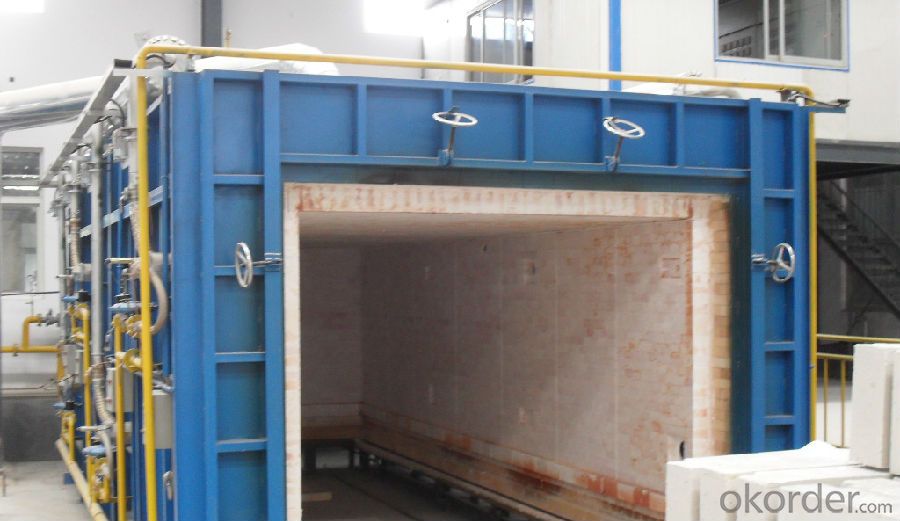
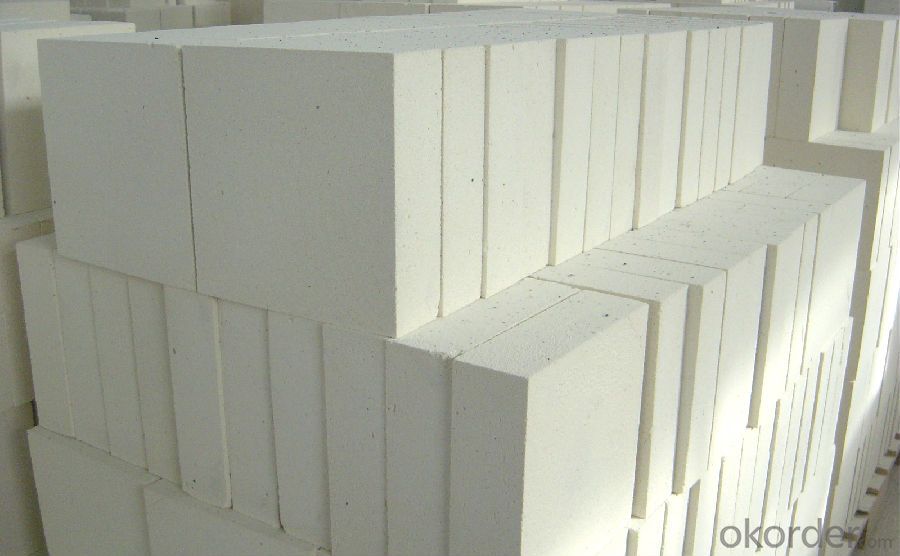
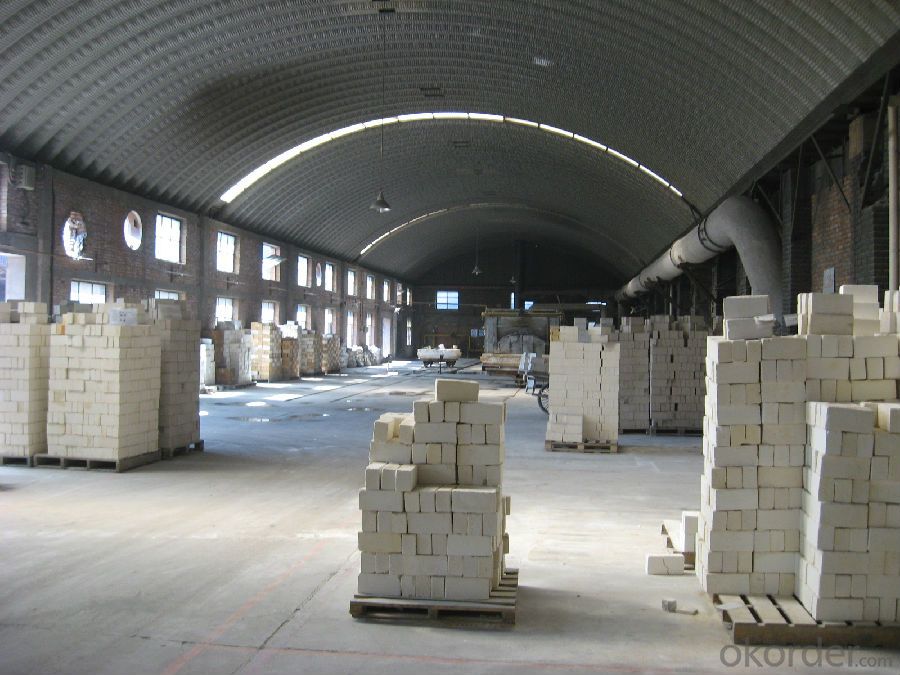
- Q:What is the typical thermal expansion coefficient of an insulating fire brick?
- The thermal expansion coefficient of an insulating fire brick can differ depending on its material composition and manufacturing process. However, as a general rule, insulating fire bricks have a lower thermal expansion coefficient compared to other brick types. This coefficient measures the degree to which a material expands or contracts when exposed to temperature changes. Typically, the thermal expansion coefficient of an insulating fire brick falls within the range of 5 to 8 x 10^-6 per degree Celsius (5-8 μm/m°C). In simpler terms, for every one degree Celsius increase in temperature, the insulating fire brick expands by approximately 5 to 8 micrometers per meter of length. The low thermal expansion coefficient of insulating fire bricks is highly desirable in applications where there are frequent and significant temperature fluctuations. This characteristic helps minimize the risk of thermal stress and cracking, ensuring that the insulating fire brick remains durable and performs well in high-temperature environments. It should be noted that the specific thermal expansion coefficient may vary depending on factors such as the manufacturer, type of insulating fire brick, and intended temperature range. Therefore, it is advisable to consult the manufacturer's specifications or technical data sheets for precise and detailed information regarding the thermal expansion coefficient of a particular insulating fire brick.
- Q:What is the recommended method for installing insulating fire bricks?
- The recommended method for installing insulating fire bricks is to first prepare the surface by cleaning it thoroughly and ensuring it is dry. Then, apply a thin layer of refractory mortar to the surface where the bricks will be placed. Carefully lay the bricks in a tight, staggered pattern, pressing them firmly into the mortar. Use a level to ensure they are properly aligned. Allow the mortar to dry completely before subjecting the bricks to heat.
- Q:Can insulating fire bricks be used in the construction of hearth furnaces?
- Yes, insulating fire bricks can be used in the construction of hearth furnaces. These bricks are designed to withstand high temperatures and have excellent insulation properties, which makes them ideal for creating the lining of a hearth furnace. Their ability to retain heat and resist thermal shock helps in maintaining a stable and efficient heating environment in the furnace.
- Q:Are insulating fire bricks suitable for use in carbon black furnaces?
- Insulating fire bricks, made from refractory materials with excellent insulation properties, are well-suited for carbon black furnaces. These furnaces, operating at temperatures exceeding 1,000 degrees Celsius, benefit from the use of insulating fire bricks by reducing heat loss and improving energy efficiency. The bricks' thermal shock resistance is crucial for the cyclic heating and cooling within the furnace. Furthermore, their low thermal conductivity helps maintain a stable temperature inside the furnace and prevents excessive heat loss. In conclusion, insulating fire bricks provide a dependable and efficient lining option for carbon black furnaces.
- Q:Can insulating fire bricks be used in the construction of lime calciners?
- Indeed, the utilization of insulating fire bricks is feasible when constructing lime calciners. Lime calciners necessitate elevated temperatures for lime production, and insulating fire bricks are specifically engineered to endure and preserve heat. These bricks possess a reduced thermal conductivity, which effectively insulates the calciner and impedes heat dissipation. Furthermore, insulating fire bricks are lightweight, facilitating their handling and installation during the lime calciners' construction process.
- Q:Can insulating fire bricks be used for insulation in aluminum smelters?
- Yes, insulating fire bricks can be used for insulation in aluminum smelters. Insulating fire bricks are made from special lightweight materials that have high insulating properties, making them ideal for applications that require high-temperature insulation. Aluminum smelters operate at extremely high temperatures, and insulating fire bricks can effectively withstand and retain the heat, preventing heat loss and improving energy efficiency. Additionally, these bricks are resistant to thermal shock, a common occurrence in smelting processes, which makes them highly suitable for use in aluminum smelters. Insulating fire bricks can also provide a protective barrier, reducing the risk of heat damage to the surrounding structures and equipment. Therefore, using insulating fire bricks for insulation in aluminum smelters can enhance thermal efficiency, reduce energy consumption, and ensure a safe and efficient smelting process.
- Q:Are insulating fire bricks resistant to saltwater?
- Insulating fire bricks generally lack resistance to saltwater. Saltwater comprises substantial amounts of salt, leading to the gradual corrosion and deterioration of the material. To ensure corrosion resistance, it is advisable to opt for refractory materials explicitly engineered for enduring saltwater environments.
- Q:Can insulating fire bricks be used in smelting furnaces?
- Yes, insulating fire bricks can be used in smelting furnaces. Insulating fire bricks are designed to have low thermal conductivity, which helps to conserve heat and maintain high temperatures inside the furnace. This makes them an ideal choice for smelting furnaces where high temperatures are required. Additionally, insulating fire bricks also have a high resistance to thermal shock, which means they can withstand rapid temperature changes without cracking or breaking. This is particularly important in smelting furnaces where the temperature can fluctuate significantly. Overall, insulating fire bricks are an excellent option for smelting furnaces as they help to improve energy efficiency, reduce heat loss, and provide durability in high-temperature environments.
- Q:Do insulating fire bricks require any special installation techniques?
- Special installation techniques are necessary for insulating fire bricks. These bricks are designed to offer excellent thermal insulation, so proper installation is essential for optimal performance. To begin, it is crucial to have a clean and debris-free installation surface. This creates a strong and stable foundation for the bricks. Afterward, it is important to use a suitable refractory mortar or adhesive to secure the bricks in place. This mortar should be specifically designed for high-temperature applications and capable of withstanding thermal expansion and contraction during heating and cooling cycles. During installation, attention should be given to filling the joints between the bricks with mortar. This prevents heat loss and maintains the insulating properties of the bricks. Furthermore, careful stacking and alignment of the insulating fire bricks is necessary to ensure a tight fit and minimize gaps. This maximizes insulation and prevents heat leakage. Lastly, it is advisable to consult the manufacturer's guidelines and follow their recommended installation techniques. Different types of insulating fire bricks may have specific requirements that must be adhered to for proper installation. In summary, insulating fire bricks demand special installation techniques to ensure their effectiveness and longevity. Following proper installation practices will enhance the thermal insulation properties of these bricks and optimize their performance.
- Q:Can insulating fire bricks be used in kiln car construction?
- Yes, insulating fire bricks can be used in kiln car construction. Insulating fire bricks are made from lightweight materials that have excellent insulating properties, such as ceramic fibers or lightweight refractory aggregates. These bricks have low thermal conductivity, which means they can effectively retain heat and prevent heat transfer to the outer surface of the kiln car. Using insulating fire bricks in kiln car construction offers several benefits. Firstly, it helps to reduce heat loss, which improves energy efficiency and lowers fuel consumption. This is particularly important in high-temperature applications like kilns, where maintaining a consistent temperature is crucial. Secondly, insulating fire bricks can help to protect the kiln car from thermal stresses and cracking. Kilns undergo significant temperature changes during firing cycles, and the use of insulating fire bricks can help to minimize thermal shock and extend the lifespan of the kiln car. Furthermore, insulating fire bricks are lightweight compared to traditional refractory bricks, making them easier to handle and install in kiln car construction. This can lead to cost savings in terms of labor and transportation. However, it's important to note that insulating fire bricks have lower strength and durability compared to dense refractory bricks. Therefore, they are typically used in the hot face lining of kilns, while a more robust material is used for the kiln car structure. In conclusion, insulating fire bricks can be effectively used in kiln car construction to improve energy efficiency, protect against thermal stresses, and enhance the overall performance of the kiln.
1. Manufacturer Overview |
|
|---|---|
| Location | |
| Year Established | |
| Annual Output Value | |
| Main Markets | |
| Company Certifications | |
2. Manufacturer Certificates |
|
|---|---|
| a) Certification Name | |
| Range | |
| Reference | |
| Validity Period | |
3. Manufacturer Capability |
|
|---|---|
| a)Trade Capacity | |
| Nearest Port | |
| Export Percentage | |
| No.of Employees in Trade Department | |
| Language Spoken: | |
| b)Factory Information | |
| Factory Size: | |
| No. of Production Lines | |
| Contract Manufacturing | |
| Product Price Range | |
Send your message to us
Insulation Brick insulating brick insulating fire brick GJM23, GJM26, GJM28, GJM30, GJM32
- Loading Port:
- Shanghai
- Payment Terms:
- TT or LC
- Min Order Qty:
- 10 m.t.
- Supply Capability:
- 1000 m.t./month
OKorder Service Pledge
OKorder Financial Service
Similar products
New products
Hot products
Related keywords
